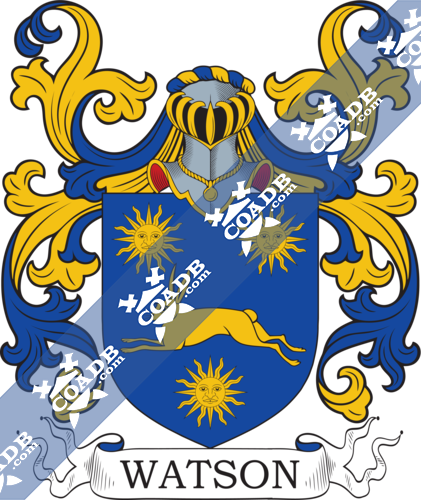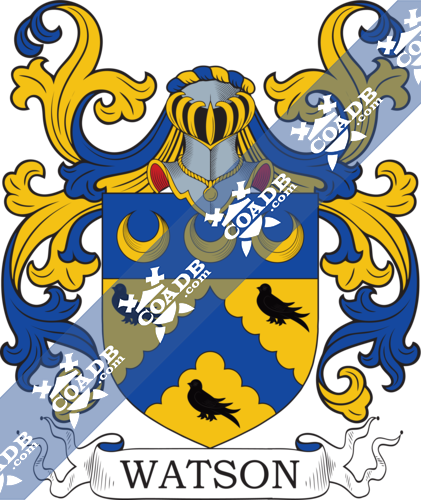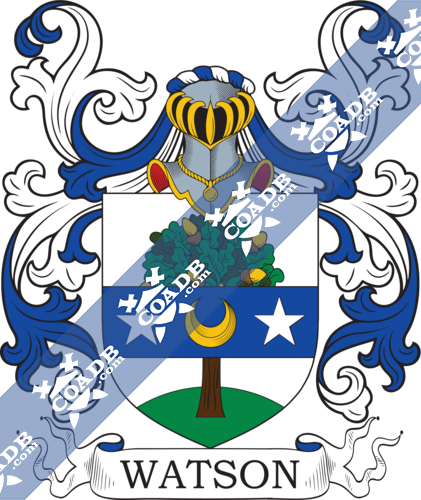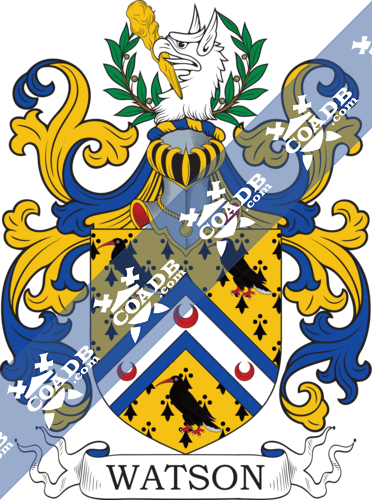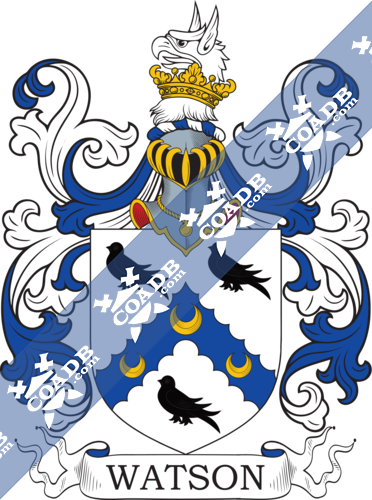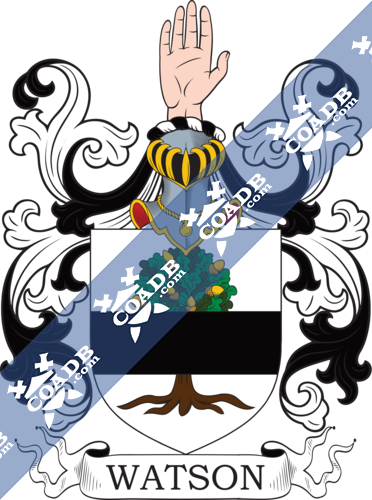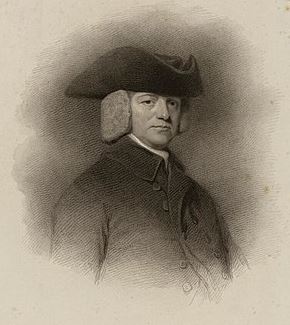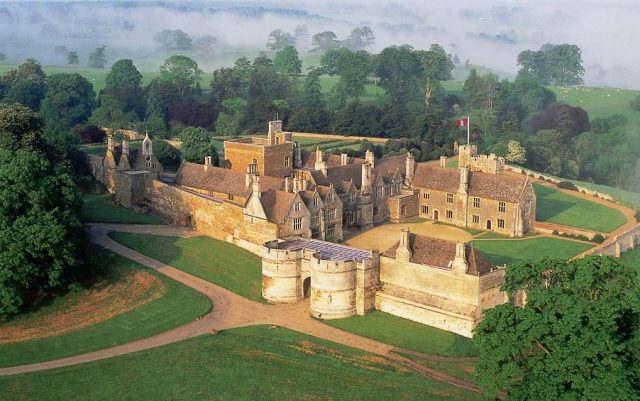Watson Family Crest, Coat of Arms and Name History

Watson Coat of Arms Gallery
Don’t know which Coat of Arms is yours?
We can do a genealogical research. Find out the exact history of your family!
Learn MoreWatson Surname Name Meaning, Origin, History, & Etymology
This is an Anglo-Scottish baptismal or patronymic surname meaning “the son of Walter”, deriving for the nickname Wat for the old personal (first) name Walter. Walter was a masculine given name of Germanic or Teutonic origins meaning “ruler of the army” consisting of the words wald (rule) and hari (army), which was introduced into England during the Norman Invasion of 1066 AD, where it replaced the Old English cognate Wealdhere, with one of the most famous bearers (hundreds of years later) being Sir Walter Scott (1711-1832) who a Scottish author. The personal name was also sometimes spelled Wautier and Waltier. Once source asserts the surname became established in county Rutland, where they were Lords of the manor of Rockingham. A castle there was garrisoned for King Charles I of England by Sir Lewis Watson, who was later created Lord Rockingham.
Spelling Variations
Common spelling variants or names with similar etymologies include Wattson, Watsone, Watsoun, Watts, Watt, Watkins, FitzWalter, and others.
Popularity & Geographic Distribution
The last name Watson ranks 76th in popularity in the United Status as of the 2000 Census. The name ranks particularly high in the following five states: Delaware, Georgia, North Carolina, Tennessee, and Arkansas.
The surname Isaac frequency/commonness ranks as follows in the British Isles: England (46th), Scotland (19th), Wales (96th), Ireland (555th) and Northern Ireland (74th). In England, it ranks highest in Durham and Northumberland. In Scotland, the Watson surname rankest highest in Peeblesshire and Fife. In Wales, it ranks highest in county Radnorshire. In Ireland, it ranks highest in Donegal. In Northern Ireland, it ranks highest in Armagh.
The name is also present throughout the remainder English speaking world: Canada (83rd), New Zealand (27th), Australia (41st), and South Africa (283rd).
The 1890 book Homes of Family Names by H.B. Guppy, states the following in regard to this surname: “The principal home of this name is in the north of England, especially in the county of Durham and in the North and East Ridings. It is also fairly numerous in the northern midlands, as in Derbyshire and Notts. Further south it rapidly diminishes, though it has several representatives in Cambridgeshire; and in the southern counties it is absent or rare, excepting Sussex, where it has obtained a hold. In the south and west of England its place is supplied by Watts. It extends in force across the Scottish border, and is found over a large part of Scotland, but is more especially characteristic of the region south of the Forth and the Clyde”.
Early Bearers of the Surname
The earliest known bearer of this surname was Peganus Wat who was documented in the Pipe Rolls of Devonshire in 1176 AD. The Hundred Rolls of 1273 AD, a census of Wales and England, known in Latin as Rotuli Hundredorum lists three bearers of this surname: William Wattes in county Oxfordshire. Richard Watson was documented in the Court Rolls of the Manor of Wakefield in Yorkshire in 1327 AD. John Wattessone was recorded in 1338 AD in the Close Rolls. The Poll Tax of Yorkshire in 1379 AD lists two bearers of this last name: Johannes Watson and Johannes Wattson. A one John Watson was documented in Scotland in 1392 AD. An early marriage involving this surname were Janes Wattes to Thomas Chamberlaine at St. Mary Aldermary in 1598 AD. Two early baptisms involving this name were Anne Watson at St. Margaret’s, Westminster in 1556 AD and Assabell Watson at St. Mary the Virgin, Aldermanbury in 1561.
George Fraser Black’s 1946 book The Surnames of Scotland, states the following in regard to this last name: “Sir Donaldus Walteri, a presbyter of the diocese of Moray, 1493, is mentioned in a document of 1612 as Sir Donald Watsone…John Watson held land in Edinburgh in 1392. Robert Watsoun was accused of being a forestaller in Aberdeen in 1402…Thomas Watson of Stanhous was one of an inquest held at Dunipace in 1426…John Watsoun of Gar-waswould was juror on an inquest made at Lanark in 1432…Nicholas Watson of Dalkeith held a land in the Appilgate of Arbroath in 1450…Walter Watson, burgess of Dumbarton, was a landowner there in 1494, and a long succession of bailies, provosts, and other town officers descend from him. In the sixteenth and seventeenth centuries the name was common throughout the Lowlands, and is one of the most common surnames in the northeastern counties. John Watsone was tenant of Uthircloy, Ardmanoch, in 1504..Some of the Macwatts, which see, on the Highland line have translated their name to Watson. Vatsone 1533, Vatsoun 1573, Wateson 1462, Watsoune 1517, Wattsone 1686”.
Watson Family Tree & Watson Genealogy
Watson of Lumclone
The lineage of this family begins with John Watson, Esquire of Crosted, in Cumberland, England who settled in Carlow and built the house of Kilconner. He married Jane West and had four children with her: John (his heir), Samuel (married Elizabeth Thompson), William, and Mary (married Robert Lecky of Kilnock). He was succeeded by his eldest son John Watson, Esq. of Kilconner who was born in 1649, and he became a Member of the Society of Friends, called Quakers, and constructed a meeting house at Kilconner. He married Anne, daughter of James Tomlinson, and had five daughters and four sons: Samuel, John (1683), Joseph (1688), and Thomas (1690). He died in 1709 and was succeeded by his eldest son, Samuel Watson, Esquire of Kilconner, born in 1782. He married Susan, daughter of Jonathan Nicholson of Ballinacarrig, and had four daughters and five sons with her: Susan (married Isaac Jacob), Anne (married Isaac Bell), Elizabeth, Phoebe (married Samuel Elly), John (his heir), Samuel (of Ballydarton, married Mary Beale and had three sons with her), Jonathan (married Deborah White), William, and Joseph. He later married Abigail Craven and Deborah Fuller, but did not have children with either. He died in 1764 and was succeeded by his son and heir, John Watson, Esq. of Kilconner who was born in 1713. In 1737, John married Jane, daughter of Joshua Clibborn of Moate, and had four daughters and five sons with her: Abigail, Jane, Sarah, Susan, Samuel, Joshua, John, George, and Robert (married Mary Forthergill). He died in 1750 and was succeeded by his son John Watson, Esq. of Kilconner House who was born in 1743. In 1773, John married Anne, daughter of Samuel Penrose of Newtown House, and had issue with her: John, Samuel, Robert, William Penrose, and Anne, He died in 1783 and was succeeded by his eldest son, John Watson, Esquire of Kilconner House who was born in 1777. In 1800, John married Elizabeth, daughter of John Lecky, of Kilnock and Ballykealy, and had seven daughters and four sons: Elizabeth Leck (married John Strangman), Anne, Jane, Mary, Sarah Augusta, Lucy Frances, Lydia Elizabeth, John Lecky, Robert, William Penrose, and George Leopold. He died in 1845 and was succeeded by his eldest son John. John was a Justice of the Peace and High Sheriff in 1860, and in 1846, married his cousin, Sarah Louisa, daughter of Thomas Henry Watson, but died without issue. Henry Forbes Montagu Watson, Esquire of Lumelone, county Carlow, was born in 1856. The family was seated at Lumclone, Fenagh, county Carlow.
Watson of Calgarth Park
The Calgarth estate was purchased from the Sandys family by Richard Watson, the Bishop of Llandaff, who was born at Heversham, Westmorland, 1737, and added an elegant mansion to it. He married Dorothea Wilson, He died in 1816. The estate was passed down to his grandson Lieutenant Colonel Charles Edward Watson of Calgarth Park, Westmorland was born in 1823 and served as Justice of the Peace, Deputy Lieutenant, and High Sheriff in 1877. He married Louisa, daughter of R.L. Watson.
Watson of Berwick Hall
James Watson, Esquire of Berwick Hall, county Salop, was Justice of the Peace for counties Stafford and Worcester who was born in 1818 and succeeded his father in 1853. He was the son of James Watson of Edgbaston. In 1856, he married Jane, daughter of Leonard Willan, Esq. Silverdale, county Lancaster, and had two issue with her: James Willan and Florence Mary.
Watson of London
Burke traces the Watson genealogy of this branch of the Watson family tree back to Joseph Watson, sometime of Thorpe-le-Soken, Essex, who in 1791, married Mary, daughter of Thomas Catton of West Dereham, and had three sons with her: Sir Thomas (1st Baronet), Joseph (born 1797, of Bocking Hall, married Mary Ann Cawston), and Reverend John (Rector of Holmpton and Vicar of Welwick). He died in 1831. His eldest son Thomas was born in 1792 and was of Henrietta Street, Cavendish Square. He became the 1st Baronet. In 1825, he married Sarah, daughter of Edward Jones, of Brackley, and had issue with him, including a son, Sir Arthur Townley Watson, 2nd Baronet who was born in 1830. In 1861, Sir Arthur married Rosamund, daughter of Charles Powlett Rushworth, and had four children with her: Sir Charles Rushworth (3rd Baronet), Arthur Gordon Catton-Watson (Captain of the 4th Bn. Royal Irish Rifles), Mabel Frederica (married Reverend Reginald Fitz-Hugh Bigg Wither), and Amy Catherine Rose. He died in 1907 and was succeeded his elder son, Sir Charles Rushworth Watson, 3rd Baronet. In 1911, Sir Charles married Evelyn Mary Elizabeth, daughter of Aubrey Thomas Cartwright of Edgcote Park, and had two issue with her: Sir Thomas Aubrey (4th Baronet), John Rushworth, and Eleanor Mary. Sir Thomas Aubrey Watson, 4th Baronet, was Lieutenant of the Life Guards, who served in World War II, and was born in 1911. In 1935, he married Ella Marguerite, daughter of Sir George Herbert Farrar, and had issue with her. Sir James Andrew Watson was 5th Baronet who was born in 1937 and succeeded his father in 1941. The Watson Coat of Arms is blazoned as follows: Azure, on a fesse dancette between three crescents argent, as many martlets sable. Crest: A gryphon’s head erased azure, ducally crowned or, between two branches of palm proper. Motto: Haohmata Maohmata. They resided at Glebe House, Kineton.
Watson of Newport
In 1906, he married Gertrude Margaret, daughter of James Mountain of Leeds, and had a daughter with her: Daphne Lewin, who was born in 1907 and in 1932, married Lieutenant-Commander John Michael Southwell. The lineage of ancestry traces back to Gregory Watson of Ingleby Greenhow, York, who in 1594, married Margaret Wood and had issue with her. His son William Watson was born in 1597. This William in turn had a son named Gregory Watson of Low Greenhow. In 1645, he married Anne, daughter of John Harrison. He had a son, also named Gregory, who in 1687, married Elizabeth, daughter of James Ridsdale, having issue with her. His son James Watson of Ingleby was born in 1704. He married a woman named Bridget and had a son with her named John. John was born in 1732, and in 1764, he married Ann, daughter of William Eldin, with whom he had a son, named Joseph. This Joseph Watson of Great Ayton, county York was born in 1775 and in 1809, married Sarah, daughter of Samuel Hornby of Great Ayton, having issue with her. One such issue was Edward Watson of West Hartlepool who was born in 1826. In 1850, he married Agnes Jervise of Cupar Fife and had two sons with her: Sir Thomas Edward and Charles (married Mynie Frances Constable). The elder son, Sir Thomas Edward Watson, 1st Baronet, was Justice of the Peace in county Monmouth, High Sheriff in 1911, and Justice of the Peace for Newport. He was born in 1851 and was created a Baronet in 1918. In 1874, he married Mary Elizabeth, daughter of Thomas Harrison of Scarborough, and had issue with her: Sir Wilfrid Hood (2nd Baronet), Sir Geoffrey Lewin (3rd Baronet), and Ada Beatrice. He died in 1921, and he was succeeded by his elder son, Sir Wilfrid Hood Watson, who died in 1922 and was succeeded by his younger brother. Sir Geoffrey Lewin Watson, 3rd Baronet, of Newport, county Monmouth, was a Lieutenant in the R.N.V.R who was born in 1879. The Watson Coat of Arms (mistakenly called the Watson Family Crest) is blazoned in heraldry as follows: Quarterly: 1st and 4th Watson, argent on a chevron azure, between three martlets sable as many roses argent barbed and seeded proper; 2nd and 3rd Harrison, Argent, a bend embattled, counter-embattled gules, over all in chief a portcullis azure, all within a bordure of the second. Crest: In front of an increscent argent, a gryphon’s head erased sable collared or. This branch of the family tree resided at Lower Mill, Longparish, Hantshire.
Watson of Sulhamstead
Sir Norman James Watson, 2nd Baronet, of Sulhamstead, Sulhamstead Abbotts, Berkshire, was High Sheriff in 1940 and a Lieutenant Colonel who served in both World Wars. He succeeded his father in 1930. Burke traces the lineage back to John Watson of Ansley, county Warwick, who in 1655, married Frances Hankins, having five sons with her. One of these sons was John Watson of Ansley, who was born in 1666, having had five issue prior to his death in 1728. His youngest son was Thomas Watson, of Nutters Heath, Ansley, who married a woman named Elizabeth and had five sons and four daughters with her. His fourth son was Joseph Watson of Ansley, who married a woman named Elizabeth and had six sons and two daughters with her. His 4th son was John Watson, daughter of Thomas Hinks of Nuneaton, and had a son with her named William. William Watson of the Elms, Temple Balsall, county Warwick, born 1828, married, in 1857, Emma, daughter of William Wakefield of Claybrook, and had issue with him: Sir William George, Charles Henry (married Marie Watson), and John Alfred (of Chadwick Manor, Knowle, High Sheriff in 1927, married Mary Anne Lea). The eldest son, Sir William George Watson, 1st Baronet, Lord of the Manor of Sulhamstead Abbotts; was High Sheriff in county Berkshire, 1920 was born in 1861 and created a Baronet in July 1912. In 1887, he married Mary Charlotte, daughter of Thomas Atkinson of Workington, and had three issue with her: Norman James (2nd Baronet), Victor William (born 1908), and Florence (married James Nagle of Toronto). The Watson Coat of Arms is blazoned as follows: Argent, a chevron azure between three martlets sable, all within a bordure of the second charged with eight crescents of the first. Crest: A gryphon’s head erased sable, gorged with a crown pallsado or, holding in the beak a sprig of oak fructed proper. The family motto is Esto quod esse videris.
Inglefield-Watson
The lineage of this family traces back to Thomas Watson, of Cupar, Fife, who was born in 1760 and in 1782, married Elizabeth Dykes and had three sons with her: Thomas (1783), David (1785), and John. The third son, John Watson, of Bathville, county Linlitgow, was born in 1791 and married Ann, daughter of John Hendry of Kirkintilloch and had two issue with her: Thomas (born 1817) and Sir John Watson (1st Baronet). The aforementioned Sir John was Deputy Lieutenant and Justice of the Peace for county Lanark who was born in 1819 and was created a Baronet in 1895. In 1846, he married Agnes, daughter of Robert Haig Simpson of Glasgow, and had four children with her: John (1853), Sir John (2nd Baronet), Thomas William (of Neilsland, Hamilton, married Lucy Hamilton), and Marianne (married Oliphant Williamson). The 4th Baronet was Sir Derrick William Inglefield-Watson, born in 1901 and succeeded his brother in 1918. He was a Captain in the Royal West Kent Regiment and served in World War II. In 1925, he married Margrett Georginia, daughter of Colonel Thomas Stokes George Hugh Robertson-Aikman, and had issue with her: John Forbes (1926) and Sheila Margrett (1931). He later married Therese, daughter of Charles Bodon of Budapest. The Watson Coat of Arms is blazoned as follows: Parted per pale argent and or, an oak tree proper, growing out of a mount in base vert, surmounted of two bars, sable. Crest: The stump of an oak tree with a branch sprouting from either side, each grasped by a hand issuing from a cloud, all proper. Motto: Insperata floruit. This family resided at Ringshill Place, Wouldbam, near Rochester, Kent.
Milne-Watson
The last person the book mentioned in this family is Sir David Ronald Milne Milne-Watson, 2nd Baronet, of Ashley, in the Parish of Longbredy, county Dorset who was educated at Balliol College and served in World War II as Captain of the 2/5th Royal Urkha Rifles. He was born in 1904 and succeeded his father in 1945. The genealogy of this family traces back to David Watson of Edinburgh, Scotland who was born in 1807 and in 1867, married Anne Carnegie, daughter of William Milne. Their son, Sir David Milne, was created a Baronet in 1937. The Watson Coat of Arms is blazoned as follows: Argent, on a mount vert an oak tree proper fructed or, over all a chevron azure charged with two mullets gold. Crest: A demi-griffin sable gorged with an antique crown and charged on the body with two mullets polewise or. Motto: Deo et patriae omnia debeo. They resided near Ashley Chase, near Abbotsbury, Dorset.
Watson Family Tree & Pedigree
John Watson was born in Aberdeenshire, Scotland in 1386 AD. He married Janet McDonald and had a son with her named William. William was born in the same area in around 1415 AD and he married Patricia Elizabeth Hale, with whom he had a son named Daniel. This Daniel Watson was born around 1450 and he married Matilda Henderson and had a son with her named John. John was born around 1472 in Holme-on-Spalding-Moor, Yorkshire, England. He married Margaret (last name unknown) and Agnes Young, fathering the following children: Thomas, John Sr., Richard, Robert, Agnes, and Margaret. His son John (or James) Watson was born in the same town around 1500. He married Margaret Sotheron and had the following children: Sir James, Henry, Thomas, Jane (Colder), Maria (or Isabel), John II, Thomas, and John. His son Sir James was a Knight, born in the same town around 1530 or before. He married several times and had numerous issue: Mary, Dorothy (Gathrone), Isabel, Christopher, Katherine, William, Prudence, Constance, Margaret Janet (Ireland), Katherine (Patched), and Alice, along with several others.
Edward Watson was born in Market Harborough, Leicestershire, England in 1460 AD. He married Alice Moore and had a son with her named Edward. This Sir Edward Watson was born in the same town in 1486. He married Emma Smith and had two daughters with her: Barbara (Hudson) and Eleanor.
Early American and New World Settlers
John Watson came to Virginia aboard the William & John (in 2619 or 1620?).
James Watson came to Virginia aboard the George in 1623.
John Watson came to Virginia aboard the Swan in 1624.
John Watson came to New England in June 1632.
Joseph Watson, age 28, came to Virginia aboard the Bonaventure in January 1634.
Thomas Watson, age 29, came to St. Christopher’s aboard the Paul of London in April 1635.
Abraham Watson, age 19, came to St. Christopher’s aboard the Paul of London in April 1635.
Nicholas Watson, age 26, came to the Barbados aboard the Alexander in May 1635.
Christoper Watson, age 21, came to St. Christopher’s aboard the Mathew of London in May 1635.
Joseph Watson, age 22, came to Virginia aboard the Speedwell of London in May 1635.
Francis Watson, age 16, came to Bermuda aboard the Truelove of London in June 1635.
Margaret Watson, age 18, came to Virginia aboard the Transport of London in July 1635.
William Watson, age 24, came to Virginia aboard the Transport of London in July 1635.
Abram Watson, age 17, came to Virginia aboard the Globe of London in August 1635.
Nicholas Watson, age 16, came to Virginia aboard the Safety in August 1635.
Alice Watson, age 30, came to Virginia aboard the George in August 1635.
William Watson, of Ruth, was buried in the parish of St. Michael’s in June 1679.
Other early settlers in colonial America bearing this surname include Anna Watson (Philadelphia 1701), Charles Watson (New England 1711), George Watson (Georgia 1775), and Ann Watson (1776).
In Canada, some of the earliest settlers bearing this last name were Henry and Brooks Watson, who came to Nova Scotia in 1749 and 1750, respectively. In Australia, two of the earliest bearers were James and Richard Watson, convicts from York and Lancaster, England, respectively, who came aboard the Ann in 1809, living in New South Wales (then a penal colony). In New Zealand, several bearers of this surname arrived in Auckland and Wellington (in the later, aboard the Harrington): James, T.H., R., and Louisa Watson.
Early Americans Bearing the Watson Family Crest
Charles Bolton’s American Armory (1927) contains two entries for this surname:
1) Argent three bars gules charged with three crescents two and one ermine. In chief two tilting spears crossed and broken. Motto: Ferio tego. Bookplate Eleanor Whitney Watson in lozenge, 1906, by Spenceley. Also of Margery Willard Watson, 1908.
2) Azure (or argent?) or a chevron or (or azure?) between three martlets proper sable three crescents or. Crest: A lion’s head erased or. Embroidery on satin, owned 1923 by Soc. Pres. N. E. Antiq. Wm. Watson of Cambridge, son of Dea. Isaac, m. Catherine, daughter of John and Catherine (Blackwell) Lopez, and had Samuel, Dr. Abram A., and Catherine (Mrs. Allen), whose daughter, Elizabeth Allen, d. 1923 leaving this and the Lopez arms.
Crozier’s General Armory (1904) and Matthew’s American Armoury (1907) and Bluebook contains do not contain any blazons for Watson.
Mottoes
I have identified two Watson family mottoes:
1) Mea gloria fides (Faith is my glory)
2) Esto quod esse videris (Be what you seem to be)1
3) Insperata floruit (It has flourished unexpectedly)4
4) Florescit (It will flower)
5) Excisa virceco (unknown, something about cutting and power, perhaps)
6) Àd littora tendo (I make for the shore)2
7) Confisus viribus (Confident of my own powers)
8) Ex corde charitas (Charity from a pure heart)6
9) Super sidera votum (My desires extend beyond the stars)
10) A Deo floruit (Prosperity from God)
11) Confisus viribus (Confident in my own powers)
12) En Dieu est tout (In God is everything) (Watson and Watson-Wentworth, m. of Rockingham)
13) Forti fors bona (Fortune is favourable to the bold)
14) In hoc signo vinces (Under this sign thou shalt conquer)3
15) Per aspera belli (Through the hardships of war)5
16) Sine injuria (Without office)
17) Spero meliora (I hope for better things) (Torpichen, b. Watson)
18) Virtus sola nobilitat (Virtue alone ennobles)
19) Ferio tego “(I strike, I cover” or “I hit and shelter without fear”)
1 – Likely from Shakspeare: Men should be what they seem.
2 – An allusion to the family crest, a ship
3 – It is related by Eusebius in his life of Constantine, that when that emperor was about to engage in battle with his opponent Maxentius, AD 312, and was putting up earnest prayers for success, he saw, about noon, with his own eyes, in the heavens the trophy of the cross, placed above the sun, consisting of light, with an inscription annexed, , “In this conquer.” The sign was also seen by his army and greatly encouraged them. The same night Christ appeared to him in a vision, and commanded him to make a standard resembling the sign which he had seen in the heavens. This lie accordingly did, adorning the standard with gold and jewels, and terming it the “Labarum.” The motto variously modified is used by many families, most of whom also have a cross as part of their armorial bearings.
4 – This motto refers to the tree torn up, yet sprouting again, which forms part of the crest.
5 – Watson of Ireland, who was Commander-in-chief of the marine forces on the coast of Malabar, 1767.
6- Likely from 1 Timothy 1:5 in the Holy Bible in the Christian religion.
Grantees
We have 51 coats of arms for the Watson surname depicted here. These 51 blazons are from Bernard Burke’s book The General Armory of England, Ireland, and Scotland, which was published in 1848. The bottom of this page contains the blazons, and in many instances contains some historical, geographical, and genealogical about where coat of arms was found and who bore it. People with this last name that bore an Watson Coat of Arms (or mistakenly called the Family Crest)
1) Jonathan Watson, of St. Jame’s, Westminiser, Justice of the Peace of Hampshire, son of John of Stone Raze, 16 December 1720
2) Watson-Wentworth, [Sir Thomas, K.B.], Baron Malton [28 May 1728]. Supporters, 1728,
3) Watson, [Lewis Monson], Baron Sondes [2nd son of the 1st Baron] [assumed the name of Watson]. Supporters, 1760.
4) John, son of James, of Brockhill, county Antrim, Ireland, 1767
5) Watson, late Wood, William, Henry (and Uncle George), of Holerood and Old Malton Abbey, county York
6) late Baker, Richard, of Malton Abbey, county York, 1818
7) late Wood, John Webster, of Gnillard’s Oak, Midburst, county Sussex, and Holly Hall, Old Malton Abbey, co. York, 1839
8) late Newton, William, of county York, 1839
9) Brook Watson of Kingston-upon-Hull, county York and East Sheen, co. Surrey, Barts., 1804
10) Watson to Bullock, Major of Militia, county Essex, 1810
11) Watson, before Taylor, of Wiltshire, Quarterly Arms, 1815
12) Watson to Milles, George John, second son of Baron Sondes (became 4th Baron), county Kent and Nofolk, 1820
13) Watson to Farsyde, George James, of the Middle Temple, London, county York, 1826
14) Watson-Samwell, of Upton, county Northampton, 1831
15) Lieutenant-General Sir James Watson, K.C.B., 1839, of Windover, Bucks, 1840
16) of Beeston, county Nottingham, 1852
17) Watson, late Brough, Robert, or county York, 1854
18) Thomas Watson, M.D. of Thorpe, county Essex, President of the Coll. of Physicians, Bart. , 27 June 1866
19) John Watson of Bowdon, co. Chester, and Kidderminster, co. Worc., Thomas Clemans Watson of Holland Park, London, son of John, son of Joseph, son of John, and to descendants of his uncle Richard, deed 1876
20) William Watson, Lord of Appeal. Arms, Lyon Register, Baton Watson, of Thankerton, county Lanark, and Edinburgh, Scotland, 28 April 1880, Life Peer, extinct 1899, Supporters, 1880.
21) John William Watson of Eccleston Square, London, 1889
22) Watson-Armstrong, W.H.A.F., of Craigside, Rothbury, county Northumberland, son of John William, 1889
23) Sir H.E. of Shirecliffe Hall, Sheffield, county York, 1882
24) Sir Charles Watson-Copley, Bart, died 6 April 1888, 12 March 1887
25) James Watson of Whitehall Court, London, and Rouen, France, 1893
Notables
There are hundreds of notable people with the Watson surname. This page will mention a handful. Famous people with this last name include: 1) Alexander Fletcher Watson (1939) who was an American ambassador and diplomat educated at Harvard and the University of Wisconsin who served as Consul in Madrid and Santo Domingo, 2) Allen Kenneth Watson (1970) who was a professional baseball player from Jamaica, New York who played for six different MLB teams as a pitcher from 1993-2000, including the St. Louis Cardinals and Anaheim Angels, 3) Anthony Watson (1549-1605) who was an English Bishop born in Durham, educated at Christ’s College, Cambridge, 4) Arthur Kittredge “Dick” Watson (1919-1974) who was the president of IBM World Trade Corporation and the 21st United States Ambassador to France from 1970-2972 during the Nixon Administration, 5) Sir Brook Watson (1st Baronet, 1735-1807) who was an British merchant and solider born in Plymouth, Devon who became the Lord Mayor of London, 6) Bryan Joseph Watson (1942) who was a professional hockey player born in Bancroft, Ontario, Canada and played for six different NHL teams, including the Montreal Canadians and Washington Capitals, as well as several WHA and AHL teams, 7) Gerry Lester “Bubba” Watson (1978) who is an American professional folder having won several championships including the Masters Tournament in 2012 and 2014, 8) Clarence Wayland Watson (1864-1940) who was a coal mining magnate who was a Senator from West Virginia from 1911-1913, 9) Vice Admiral Charles Watson (1714-1757) who was an officer in the Royal Navy who served as the colonial Governor of Newfoundland, Canada, 10) Cahrles Watson-Wentworth (1730-1782) was the 2nd Marquees of Rockingham and the Prime Minister of Great Britain in 1782, 11) David Watson (1870-1924) who was a Scottish born politician who became a Senator for New South Wales, Australia in 1914, and 12) Ellen Liddy Watson (1860-1889) who was a pioneer of Wyming, mistanely called Cattle Kate, who was born in Bruce County, Ontario, a rancher who was lynched for political reasons, becoming a legendary figure of the Old West.
Blazons & Genealogy Notes
2) (Baron Sondes, now Milles. Hon. Lewis Monson, second son of John, first Baron Monson, by Lady Margaret Watson his wife, dau. of Lewis, first Earl of Rockingham, by Katherine Sondes his wife, dau. of Sir Geobge Sondes, K.B., of Lees Court, co. Kent, having s. to the Rockingham and Lees Court estates under the will of Thomas, third and last Earl of Rockingham, assumed the surname and arms of Watson, and was created, 1760, Baron Sondes, of Lees Court, co. Kent ; the fourth baron assumed the name and arms of Milles only). Quarterly, 1st and 4th, ar. on a chev. engr. az. betw. three martlets sa. as many crescents or, for Watson; 2nd and 3rd, or, two chev. gu. a crescent for diff., for Monson. Crest—A griffin’s head erased ar. ducally gorged or. Supporters—Dexter, a griffin ar. dlically gorged or; sinister, a bear ppr. gorged with a, belt ar. rimmed, buckled, and charged with three crescents or, the strap pendent ar. charged with three crescents or. Motto—Esto quod esse videris. See Milles, Baron Sondes.
3) (Fulmer, co. Bucks, hart.). Ar. on a chev. engr. az. betw. three martlets sa. as many crescents or. Crest—A griffin’s head erased ar. ducally gorged or. Motto—Esto quod esse videris.
4) (Henrietta Street, London, hart.). Az. on a fess dancettee betw. three crescents at. as many martlets sa. Crest—A gryphon’s head erased az. ducally crowned or, betw. two branches of palm ppr.
5) (Congleton, co. Chester). Ar. on a chev. engr. az. betw. three martlets sa. as many crescents or. quartering Holland and Yates. Crest—A griffin’s head erased ar. charged with two chevronels gu. holding in the beak a cinquefoil vert.
6) (Frendsbury, co. Kent, and Walpett, co. Suffolk). Barry of six ar. and gu. three crescents erm. on a chief or, two broken spears in saltire of the second. Crest—On a mount vert a demi dragon ramp. ppr.
7) (co. Lancaster). Ar. on a chev. engr. az. betw. three martlets sa. as many crescents or, a border engr. of the third.
8) (Hughfield, co. Middlesex, and Gisborough, co. York). Or, on a chief vert three martlets of the field. Crest —An ermine pass. ar. collared, ringed, and lined or.
9) (Lidington, co. Rutland). Ar. on a chev. engr. az. betw. three martlets sa. as many crescents or, each charged with a torteau.
10) (co. Rutland). Ar. on a chev. engr. betw. three martlets sa. as many crescents or.
11) (Newport, co. Salop). Or, on a chief vert an ermine pass. ppr. Crest—An ermine pass. ppr. ruined on the shoulder gu.
12) (Ampthill, co. Bedford). Ar. a fess gu. in chief two crosses botonnee of the last.
13) (Conington, co. Cambridge). Ar. on a chev. engr. az. betw. three martlets sa. as many crescents or. Crest—griffin’s head erased sa. gorged with two bars gemel ar.
14) (co. Cumberland). Ar. a fess embattled gu. in chief two crosses botonnee of the last. Crest—An arm embowed in armour ppr. garnished or, holding in the gauntlet a palm branch vert.
15) (cos. Cumberland and Kent, and London). Ar. a fess gu. in chief three crosses botonnee of the second. Crest—On a mount vert a palm tree or.
16) (Stratford, co. Gloucester). Az. a hare courant betw. three suns or.
17) (Stratton, co. Gloucester). Az. a chev. erm. in chief two conies courant or, in base a sun of the last.
18) (co. Hants). Az. a fess erm. betw. three suns or, Crest—On a chapeau gu. turned up. erm. a talbot statant of the second, collared or.
19) (co. Surrey; granted 8 Sept. 1596). Erm. on a chief gu. a sun or.
20) (Hardendale, co. Westmorland; originally of Scotland). Ar. on a mount an oak tree inclining to the sinister ppr. acorned or, debruised by a fess az. Crest—Two arms issuing from clouds, holding the stump of a tree fructed at the top, with branches on each side, all ppr.
21) (Kidderminster, co. Worcester, and of Holland Park, London). Az. on a chev. nebuly betw. two martlets in chief and a rose in base ar. three crescents of the field. Crests: In front of a gryphon’s head erased az. collared and holding in the beak a branch of two roses ar. leaved and slipped ppr. an escutcheon also ar. charged with a martlet az. Motto—Esto quod esse videris.
22) (Bengeworth, co. Worcester). Az. a fess erm. betw. three suns or. Crest—A dog pass. collared or.
23) (Wath Cottage, Pickering, co. York). Erminois on a chev. az. betw. three Cornish choughs ppr. Another chev. ar. charged with three crescents gu. Crest—A griffin’s head erased ar. betw. two branches of laurel ppr. in the beak a club or.
24) (Silsden, co. York). Ar. on a chev. engr. az. betw. three martlets sa. as many crescents or. Crest—A griffin’s head erased ar. holding in the beak a sprig leaved vert.
25) Same Arms. Crest—A griffin’s head erased ar. in the beak a flower gu. charged on the breast with two chev. sa.
26) (co. York). Same Arms. Crest—A griffin’s head erased ar. ducally gorged or. Motto—Mea gloria fides.
27) Same Arms, each crescent charged with a torteau. Crest—A griffin’s head erased ar. on the neck two chev. sa. in the mouth a branch of roses gu. leaved vert.
28) Ar. a fess gu. in chief three crosses botonnee of the last.
29) Per fess gu. and az. three suns or.
30) Ar. on a bend betw. six lions ramp. sa. three lions pass. of the field.
31) (exemplified to Robert Brough, Esq., of Melton, co. York, upon his assuming, by i;oyal licence, the surname of Watson). Erm. within two chevronels engr. betw. three martlets an estoile betw. two crescents sa. Crest—Issuant from a sun rising in splendour ppr. a gryphon’s head sa. semee of estoiles or.
32) (James Watson, Sheriff of Dublin, temp. Charles I.; Fun. Ent. Ulster’s Office, 1630, of his wife, Margery, dau. of William Hames, co. Leicester). Ar. on a bend betw. Six lions ramp. sa. three lions pass, of the field.
33) (Fun. Ent. Ulster’s Office, 1632, Anne, dan. Of William Watson, Esq., and wife of Willlam Hobart, Esq., of Ravenshall, co. Suffolk). Or, a chev. engr. az. betw. three martlets sa. on a chief of the second three crescents in fess of the first.
34) (Kilmanahan Castle, co. Waterford; confirmed to Thomas Wright Watson, Esq., of that place, and to the other descendants of his grandfather, Thomas Watson, Esq., of Haydon Hall, co. Middlesex). Ar. on a chev. engr. az. betw. three martlets sa. a trefoil enclosed by two crescents or. Crest—A griffin’s, head erased ar. ducally gorged or, and charged with a trefoil vert. Motto—Esto quod esse.
35) (Saughton, co. Edinburgh). Ar. an oak tree growing out of a mount in base ppr. surmounted of a fess az. Crest—Two hands issuing out of clouds holding the trunk of an oak tree sprouting out fresh branches ppr. Supporters (granted 1818)—Two griffins ppr. each gorged with a ducal coronet or. Motto—Insperata floruit.
36) (younger brother of Saughton, 1673). As the last, the fess charged with an acorn of the field for diff. Crest—An oak slip ppr. Motto—Florescit.
37) (Aberdeen, 1672). Ar. an oak tree growing out of the base ppr. surmounted of a fess az. charged with a crescent or, betw. two mullets of the field.
38) (Dundee, 1672). Ar. an oak. tree issuing from a mount vert surmounted of a fess az. charged with a cinquefoil betw. two stars of the field.
39) (Peterhead, co. Aberdeen, 1672). Ar. on oak tree growing out of the base ppr. surmounted of a fess az. charged with a fleur-de-lis betw. two mullets of the field. Motto—Excisa virceco.
40) (Glentarkie, co. Fife). Ar. an oak tree growing out of a mount in base ppr. surmounted of a fess wavy az. charged with a sail of the first. Crest—A ship under sail ppr. Motto—Àd littora tendo.
41) (Crosslet, co. Dumbarton). Ar. an oak tree eradicated ppr. surmounted of a fess sa. Crest—A dexter hand erect ppr. Motto—Confisus viribus.
42) (Muirhouse, co. Edinburgh, 1722). Ar. an oak tree eradicated ppr. surmounted of a fess az. charged with a grififin’s head erased of the first. Crest—A demi griffin holding in his dexter paw a dagger ppr.
43) (Edinburgh, 1739). Ar. an oak tree acorned growing out of a mount in base ppr. surmounted of a fess wavy az. charged with three bezants. Crest—A flaming heart ppr. Motto—Ex corde charitas.
44) (Nielsland, co. Lanark, 1871). Per pale ar. and or, an oak tree growing out of a mount in base vert, surmounted of two bars sa. Crest—The stump of an oak tree with a branch sprouting from either side grasped by a hand issuing from a cloud all ppr. Motto—Insperata floruit.
45) (Broomieknowe, co. Dumbarton; Lord Provost of Glasgow, 1872). Ar. an oak tree growing out of a mount in base ppr. surmounted of a fess az. charged with a redbreast also ppr. Crest—A mullet ar. Motto—Super sidera votum.
46) (Baron Watson). Or, an oak tree ppr. growing out of a mount in base vert surmounted of a fesse erm. charged with two mullets az. Crest—The stump of an oak tree with two branches sprouting from it and grasped on either side by a hand issuing from a cloud, all ppr. Supporters— On the dexter side a highland deerhound ppr. and on the sinister side a lion ar. each charged on the shoulder with a thistle leaved and slipped ppr. Motto—A Deo floruit.
47) (Henry Edward Watson, Esq., of Shirccliffe Hall, Sheffield, co. York). Or, a pale gu. surmounted by a chev. invected thereon three crescents betw. as many martlets all counterehanged. Crest—In front of an eagle’s head couped gu. gorged with a crown vallery three crescents all or.
48) (John Watson, Esq., Whitney Terrace, Bowdon, co. Chester, and Thomas Clemans Watson, Esq., Holland Park, London). Az. on a chev. nebulee betw. in chief two martlets and in base a rose ar. as many crescents of the first. Crest—In front of a griffin’s head erased az. collared gemel ar. holding in the beak two white roses slipped and leaved ppr. an escutcheon also ar. charged with a martlet also az. Motto—Esto quod esse videris.
49) (Langley, co. Bucks, late Scotland). Ar. an oak tree ppr. growing out of a mount in base vert surmounted of a fesse sa. charged with three stars of six points of the first; en surtout, ar. a cross flory vert betw. four martlets gu. a chief dovetail az., for Bird. Crest—An oak tree ppr. growing out of a mount vert. Motto—Florescit.
50) (Motto: Ferio tego. Bookplate Eleanor Whitney Watson in lozenge, 1906, by Spenceley. Also of Margery Willard Watson, 1908.) Argent three bars gules charged with three crescents two and one ermine. In chief two tilting spears crossed and broken. (Source: Bolton’s American Armory, 1927).
51) (Embroidery on satin, owned 1923 by Soc. Pres. N. E. Antiq. Wm. Watson of Cambridge, son of Dea. Isaac, m. Catherine, daughter of John and Catherine (Blackwell) Lopez, and had Samuel, Dr. Abram A., and Catherine (Mrs. Allen), whose daughter, Elizabeth Allen, d. 1923 leaving this and the Lopez arms.) Azure (or argent?) or a chevron or (or azure?) between three martlets proper sable three crescents or. Crest: A lion’s head erased or. (Source: Bolton’s American Armory, 1927).



